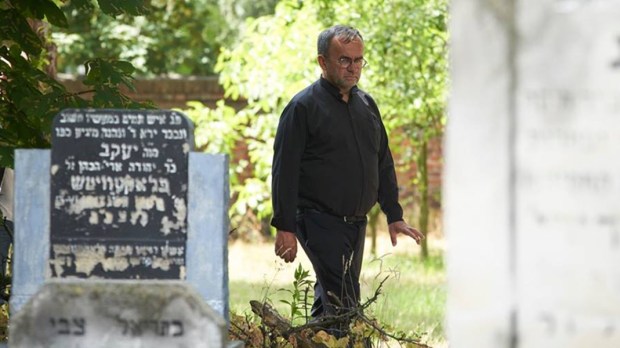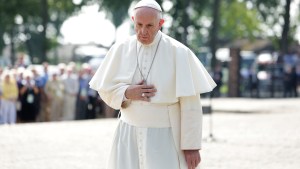Because of Fr. Patrick Desbois’ longtime work of identifying mass graves of Jews killed in the Holocaust and helping to bring closure to relatives, it’s no wonder that a member of the audience at a Jewish organization in New York would stand up and gush, “You’re an angel.”
To which the French priest responded, “I’m not an angel; I’m a simple man with a strong determination.”
Fr. Desbois founded a Paris-based organization to find the mass graves where the Nazis left some 2.2 million Jews in Eastern Europe and countries of the former Soviet Union after attempting a genocide there in the early 1940s. That organization, Yahad-In Unum, takes its name from the Hebrew word for “together” and the Latin for “in one.”
Desbois’s organization has built a record of uncovering the location of more than 2,700 killing sites where Jews were killed not in gas chambers but by firing squads. Yahad-In Unum has collected more than 6,700 witness testimonies about the war crimes. Sadly, many of those witnesses — residents of local towns and villages in a swath from the Baltics to the Black Sea — also collaborated with the of the Einsatzgruppen (Nazi Death Squads), motivated by fear of reprisal, or hatred of Jews, or greed, or a combination of the three.
The operation has come to be known as the “Holocaust by Bullets,” but has received far less attention than the concentration camps and gas chambers in Germany and Poland. This is in spite of incidents such as the massacre of 33,771 Jews killed in two days at Babi Yar in Kyiv, and the Rumbula massacre, with about 25,000 killed in two days of shooting near Riga.
Finish burying the dead
Desbois’ examination of this period of history also looks at how the Roma of Eastern Europe were victims as well.
“Everyone knows about Auschwitz — there are things there that one can see: the camp, the train, the barbed wire, the gas chamber, etc. But in the East, there is nothing to see, just a field. Even many of the synagogues were transformed by the Soviets into shops or cinemas,” he said in a talk at the YiVO Institute for Jewish Research in New York City, which studies the history and culture of East European Jewry.
Fr. Desbois said the reason his team continues documenting the Holocaust by Bullets is to “finish burying the dead.”
“I know that the Jews are one of the people most connected to the dead, by duty and by religion,” he said. “We try to help people find the graves of their loved ones. We have someone on staff whose full time job is to answer families’ inquiries and help them go back there and say Kaddish for the first time since 1942.” A “small family memorial without noise” can be provided, “to protect and sanctify the place” where the person died.
According to Catholic teaching, one of the Corporal Works of Mercy is to bury the dead.
Aside from honoring the victims, Desbois wants to help the world understand the roots of the violence, so that it can be avoided in the future. He likes to point out that the story of Cain and Abel comes very early in the Bible, but that it is a story that is repeated in every genocide.
“God asked, ‘Where is your brother?’ He didn’t ask ‘Are you guilty?’ Of course, he knows he’s dead. He’s looking for the corpse. And for me and my team, it’s surely the question we hear in our prayer, ‘Where is your Jewish brother from all these Soviet countries?’” said Desbois, who served as director of the Episcopal Committee for Catholic-Judeo Relations, under the auspices of the French Conference of Bishops from 1999 until 2016.
“Cain asks, ‘Am I my brother’s keeper?’ It means, ‘I have a lot to do. It’s sad, but he’s dead, and now I have to live my life. I don’t have to care about the corpse of my brother.’”
But, Desbois insists, it is imperative for the world to care: “We cannot build a modern Europe if we ask 2.2 million Jews to sleep under the bushes like dogs.”
Yazidis, Christians
Desbois has broadened the scope of his work to include more recent genocides, notably, the one attempted by the Islamic State group against Yazidis in Syria and Iraq in 2014. In this case, many of those who were persecuted are still alive, and his organization is trying to help them put their lives back together.
When news started breaking about ISIS invading Yazidi territory in Iraq, Desbois thought back to the Rwandan genocide of 1994, when, he admitted, he watched the news but felt no emotion.
“This time I will not stand by. I will not write ‘genocide’ on Facebook” and do nothing more, he said. “I will go. I took three days to pray about it, but at the end of the three days I had my conviction.”
Yahad-In Unum’s research in Iraq has revealed a genocide perpetrated in broad daylight that used similar methods to the ones used by the Einsatzgruppen. Its Action Yazidis project collects the testimony of survivors to document and offer evidence of every step of the genocide.
Desbois, who is Professor of the Practice of the Forensic Study of the Holocaust at Georgetown University, said in a 2018 interview with Angelus News that he is beginning to dig deeper into what happened to the Christians in Iraq as well, but he can only go so far on a limited budget. If there is funding, he envisions Yahad-In Unum beginning projects to look at the killing of Christians in places like Pakistan and Egypt as well.
He said in that interview that Cardinal Jean-Marie Lustiger, the late archbishop of Paris who was himself from a Jewish family whose mother was killed at Auschwitz, encouraged him in his work, and that the Church has always encouraged him to continue, in spite of difficulties. Yahad-In Unum opened the first Holocaust museum in Central America — in Guatemala — with the approval of the archbishop of Guatemala City, near the cathedral.
“We try to teach this generation about what happened in Europe, to help them to not enter into gangs, and to fight against violence and drugs and rape and so on,” he said. “We have the task of transmitting to the new generation: learning about the Holocaust is a way to fight against violence in daily life today. Unfortunately these children know violence, with the gangs.”
Again, he comes back to the first fratricide. “Cain was under the mask of the Nazis, now he’s in the mask of another group,” he said, in discussing ISIS. “But it’s the same evil. For me it’s really a fight against evil. It’s why I always say to my team ‘You must pray a lot, to ask God’s presence in front of that because you cannot be alone in front of evil; it’s very dangerous.'”



